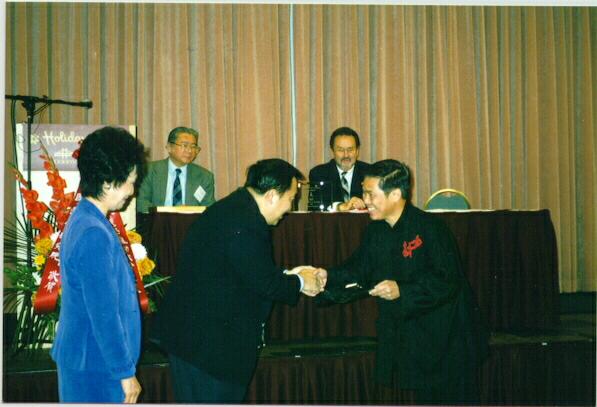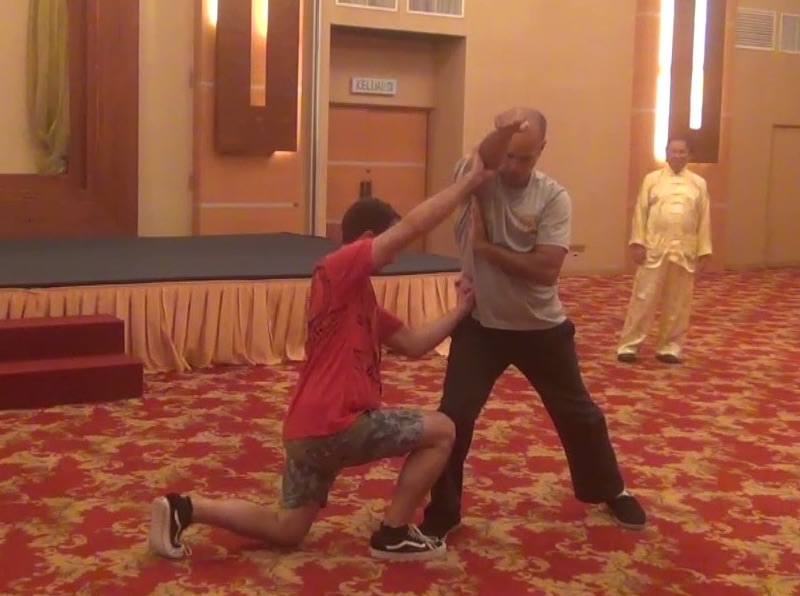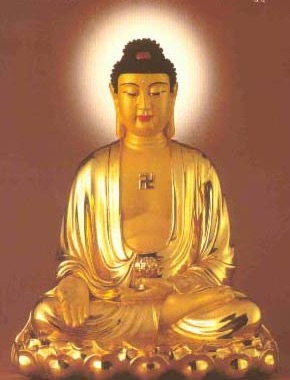SELECTION OF QUESTIONS AND ANSWERS
MAY 2018 PART 3

Grandmaster Wong receiving the Qigong Master of the Year award in 1997 at the 2nd World Qigong Congress
Question 1
Is it true that you have helped people overcome cancer? Cancer is considered an incurable disease.
— Henry, Indonesia
Answer
Yes, it is true. In fact, one of the main reasons I was awarded Qigong Master of the Year in 1997 in the 2nd World Congress of Qigong in San Francisco was because I had helped many people overcome cancer. The paper I presented at the Congress, chosen by the Congress for me, was Qigong: a Cure for Cancer and Chronic, Degenerative Diseases? A Global Interest.
Qigong, spelt as "chi kung" in English, not only overcomes cancer, but all so-called incurable diseases. From the traditional Chinese medical philosophy, all diseases can be overcome. The cause of all diseases is energy blockage, and practicing genuine chi kung clear energy blockage.
But I don't like to treat cancer; I take it as a duty. I prefer teaching kungfu and chi kung to healthy people. Now I am lucky, I can refer people suffering from cancer and other so-called incurable diseases to our certified chi kung healers, like Wong Chun Nga and Dr Foong who have produced very good results.
Question 2
My aunt has been suffering from depression for the past 2 years. I was thinking of telling her about your Intensive Chi Kung course, but doubt that she'd go. She lives in Chile and there are no instructors there.
I was thinking of recommending her to Smile from the Heart. I think that if she sees results with this, not only it would help her, but it could also convince her to take the trip.
— Alsonso, Italy
Answer
Tell her to smile from her heart. Just leave it at that. If she can't smile from her heart, or refuse to smile from her heart, don't teach her anything more.
Tell her that overcoming her depression, no matter how long it has been, is really easy, but she must make an effort to do so. Ask her to attend my Intensive Chi Kung Course. There will be one early next year. If she does not want to attend for any reason, it is her problem.

Intensive Chi Kung Course in Sabah
Question 3
Do you have any idea why the Venerable Harng Yein did not use for at least once the phoenix eye fist, snake and leopard strike and the crane beak in this 108-Pattern Essence of Shaolin set when he created it?
— Dimitri, Austria
Answer
The Venerable Yarng Yein, I believe, did not use the phoenix eye fist, the snake strike, the leopard punch and the crane beak in this 108-pattern Essence of Shaolin set because he did not find them the best techniques to be included in the set.
The phoenix eye fist, the snake strike, the leopard punch and the crane beak are not common ways of striking. Many kungfu sets do not have them. Most kungfu sets use the cup fist, the level fist and the palm strike.
Another possible reason is historical. The phoenix eye fist, the snake strike, the leopard punch and the crane beak are later development of hand forms, especially in the later part of the Qing Dynasty after the burning of the Shaolin Temple. The phoenix eye fist, however, was found earlier. It was one of the specialties of Zhang San Feng who use the phoenix eye fist for dim mark. Pak Mei, who lived a few centuries later than Zhang San Feng, but a generation earlier than Yarng Yein, also used the phoenix-eye fist for dim mark.
The phoenix eye fist and the leopard punch are found in the Wing Choon Kungfu we practice in our school. They are, however, not found in the popular style of Wing Choon from Hong Kong.
Question 4
I have not been able to attend a Small Universe course. Is it recommendable to do Abdominal Breathing every day until it may come about naturally and be better prepared for the next Small Universe? I did do courses on Abdominal Breathing. I am asking you because my brother, who was able to attend, is so very happy with the Small Universe.
— Sifu Roeland Dijkema, Shaolin Wahnam Netherlands
Answer
I could tell you the methods for the Small Universe but it is not good for you. It is better that you develop the skills during the Small and Big Universe Course. You need not pay particular attention to practicing Abdominal Breathing. Just practice the way you have been doing, including practicing Abdominal Breathing whenever you like.

Two Angels demonstrating a combat application of Essence of Shaolin
Question 5
Here is a quick question regarding Buddhism and Hinduism. I know not too much about the intricacies of Buddhism, but I know that it is fairly similar to Hinduism. A lot of stuff done in Hinduism is also done in Buddhism, and Taoism and Shintoism too I believe.
— Nareshwar, India
Answer
Apart from monotheistic religions, like Christianity and Islam, all other religions are similar, though the names the followers refer to their gods and the rituals they practice may be different due to differences of culture, language, history, geography and other factors. Hence, Hinduism, Buddhism, Taoism and Shintoism are similar.
To go deeper, even monotheistic and polytheistic religions are similar, because what monotheistic religions refer to as God, followers of polytheistic religions also refer to it as the Supreme, called variously by different terms due to different factors. The Buddhists call the Supreme as Tathagata, often translated into English as Suchness, or the Spiritual Body of the Buddha. The Taoists call the Supreme, Tao or the Great Void. Hindus call the Supreme, Brahman.
Please note that God referred to by followers of monotheistic religions is God the Holy Spirit, which is different from God the Father, who is in heaven, and different from God the Son, manifested in Christianity as Jesus Christ. This trinity concept is similar to the triple-body concept in Buddhism, expressed as the Spiritual Body of the Buddha, the Reward Body of the Buddha manifested as numerous Buddhas in various heavens, and the Physical Body of the Buddha manifested as Siddhartha Guatama in our era.
In Bhagavadgita, the holy book of the Hindus, the Reward Body of Lord Krishna manifested in the Physical Body as a chariot driver, who told the king that everything there is belongs to Brahman, God the Holy Spirit.
Interestingly, the latest science is saying the same truth. Everything there is, is a universal spread of energy. We interpret the energy as different phenomena according to our difference senses.
Question 6
However a lot of people seem to disapprove of these similarities and state that the few key points of similarity between the two are very scarce, that they are for the most part different fundamentally.
Answer
The above truth is known only to a very small group of people. The great majority, most of the followers of all religions, think that the world religions are different.
Many Buddhists today, for example, do not know that Buddhism came from India.

Amitabha Buddha
Question 7
A claim that helps further supplement this argument is that Buddhists don't believe/worship any specific gods, while Hindus do, which strikes me as off.
Answer
There are three traditions of Buddhism, namely Theravada Buddhism, Mahayana Buddhism and Vajrayana Buddhism.
For some reasons, much of information about Buddhism, especially in the West, comes from Theravada Buddhism. Generally, Theravada Buddhists do not worship specific gods, they believe in attaining Enlightenment, the highest goal in Theravada Buddhism, by following the Four-Noble Truths and the Eight-Fold Path.
Today, with the spread of Tibetan Lamas to the West, Vajrayana Buddhism has become popular. Vajrayana Buddhists believe in and worship many gods and goddesses like Yamantaka, Vaisravana, and Tara.
The largest tradition is Mahayana Buddhism, which is found in China, Japan, Korea, Vietnam and Malaysia. Mahayana Buddhists believe in and worship many gods and goddesses, or Buddhas and Bodhisattavas, like Julaifo, Amithaba, Guan Yin, Manjutsri, and Kshitigarbha.
Question 8
Along the similar practices done in both religions, I know that in Buddhism and Hinduism we both have 3 gods in common -- Buddha, Tara Devi, and Yamantaka. Could you help clarify this a bit, as to whether these claims others have made are true or false?
Answer
I speak from the Buddhist tradition I am most familiar with, i.e. Mahayana Buddhism.
There are many Buddhas and Bodhisattvas in Mahayana Buddhism, but the three most widely worshiped are Julaifo, Guan Yin Bodh Satt (Bodhisattva of Great Compassion) and Amitabha Buddha.
"Julaifo" is in Chinese, and it refers to the Spiritual Body of the Buddha, not to Guatama Buddha.
If you have any questions, please e-mail them to Grandmaster Wong via his Secretary at secretary@shaolin.org stating your name, country and e-mail address.
LINKS
Selected Reading
- Cancer Can be Cured!
- Everyone of the 108 Patterns in Essence of Shaolin is a Signature or Special Pattern
- The Amazing Intensive Taijiquan Course
- Northern Shaolin Seven-Star Set
- Our Home in Sabah
